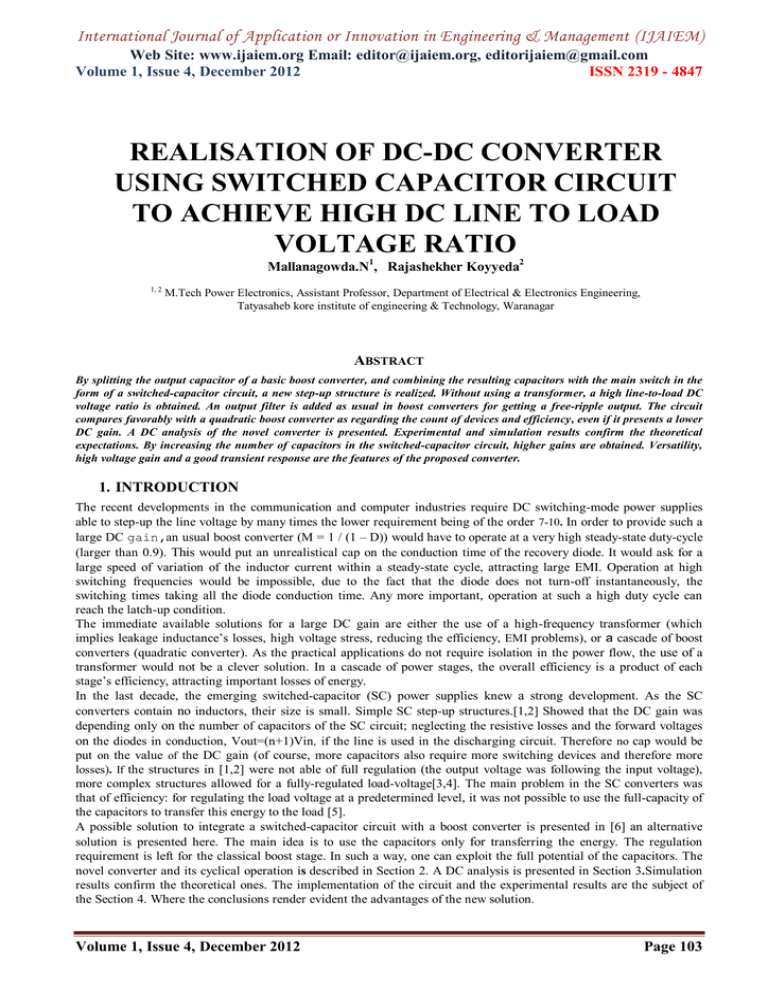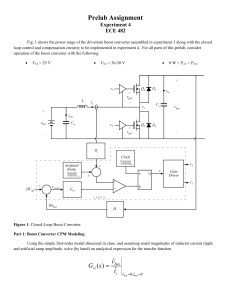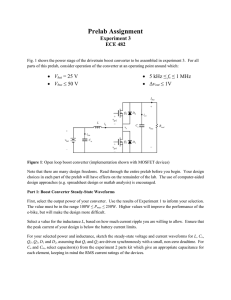International Journal of Application or Innovation in Engineering & Management... Web Site: www.ijaiem.org Email: , Volume 1, Issue 4, December 2012
advertisement

International Journal of Application or Innovation in Engineering & Management (IJAIEM) Web Site: www.ijaiem.org Email: editor@ijaiem.org, editorijaiem@gmail.com Volume 1, Issue 4, December 2012 ISSN 2319 - 4847 REALISATION OF DC-DC CONVERTER USING SWITCHED CAPACITOR CIRCUIT TO ACHIEVE HIGH DC LINE TO LOAD VOLTAGE RATIO Mallanagowda.N1, Rajashekher Koyyeda2 1, 2 M.Tech Power Electronics, Assistant Professor, Department of Electrical & Electronics Engineering, Tatyasaheb kore institute of engineering & Technology, Waranagar ABSTRACT By splitting the output capacitor of a basic boost converter, and combining the resulting capacitors with the main switch in the form of a switched-capacitor circuit, a new step-up structure is realized. Without using a transformer, a high line-to-load DC voltage ratio is obtained. An output filter is added as usual in boost converters for getting a free-ripple output. The circuit compares favorably with a quadratic boost converter as regarding the count of devices and efficiency, even if it presents a lower DC gain. A DC analysis of the novel converter is presented. Experimental and simulation results confirm the theoretical expectations. By increasing the number of capacitors in the switched-capacitor circuit, higher gains are obtained. Versatility, high voltage gain and a good transient response are the features of the proposed converter. 1. INTRODUCTION The recent developments in the communication and computer industries require DC switching-mode power supplies able to step-up the line voltage by many times the lower requirement being of the order 7-10. In order to provide such a large DC gain,an usual boost converter (M = 1 / (1 – D)) would have to operate at a very high steady-state duty-cycle (larger than 0.9). This would put an unrealistical cap on the conduction time of the recovery diode. It would ask for a large speed of variation of the inductor current within a steady-state cycle, attracting large EMI. Operation at high switching frequencies would be impossible, due to the fact that the diode does not turn-off instantaneously, the switching times taking all the diode conduction time. Any more important, operation at such a high duty cycle can reach the latch-up condition. The immediate available solutions for a large DC gain are either the use of a high-frequency transformer (which implies leakage inductance’s losses, high voltage stress, reducing the efficiency, EMI problems), or a cascade of boost converters (quadratic converter). As the practical applications do not require isolation in the power flow, the use of a transformer would not be a clever solution. In a cascade of power stages, the overall efficiency is a product of each stage’s efficiency, attracting important losses of energy. In the last decade, the emerging switched-capacitor (SC) power supplies knew a strong development. As the SC converters contain no inductors, their size is small. Simple SC step-up structures.[1,2] Showed that the DC gain was depending only on the number of capacitors of the SC circuit; neglecting the resistive losses and the forward voltages on the diodes in conduction, Vout=(n+1)Vin, if the line is used in the discharging circuit. Therefore no cap would be put on the value of the DC gain (of course, more capacitors also require more switching devices and therefore more losses). If the structures in [1,2] were not able of full regulation (the output voltage was following the input voltage), more complex structures allowed for a fully-regulated load-voltage[3,4]. The main problem in the SC converters was that of efficiency: for regulating the load voltage at a predetermined level, it was not possible to use the full-capacity of the capacitors to transfer this energy to the load [5]. A possible solution to integrate a switched-capacitor circuit with a boost converter is presented in [6] an alternative solution is presented here. The main idea is to use the capacitors only for transferring the energy. The regulation requirement is left for the classical boost stage. In such a way, one can exploit the full potential of the capacitors. The novel converter and its cyclical operation is described in Section 2. A DC analysis is presented in Section 3.Simulation results confirm the theoretical ones. The implementation of the circuit and the experimental results are the subject of the Section 4. Where the conclusions render evident the advantages of the new solution. Volume 1, Issue 4, December 2012 Page 103 International Journal of Application or Innovation in Engineering & Management (IJAIEM) Web Site: www.ijaiem.org Email: editor@ijaiem.org, editorijaiem@gmail.com Volume 1, Issue 4, December 2012 ISSN 2319 - 4847 2. NOVEL STEP-UP DC-DC CONVERTER Let's analyze the basic cell of Fig. 1 (a). It is formed by two capacitors, two diodes and an externally-controlled switch. When S is off the two capacitors are charged, each one at VC (Fig. l (b)). a. Basic SC-L cell. b. Topological switching stage: toff c. Topological switching stage: ton Figure 1: With losses neglected, = and When S is on, the two diodes are off due to , and the two capacitors are discharged in series to the load. The switching period is small enough to allow considering the capacitors as ideal voltage sources in the first approximation. With losses neglected, , By applying the average method, and taking into account that the circuit operates in the off-topology for the period of time (1-D) Ts , and in the on-topology for DTs. (where fs=1/Ts is the switching frequency), an energy balance on L, for a steady state cycle gives ( )DTs+( )(1-D)Ts=0 Or = (1+D) Volume 1, Issue 4, December 2012 (1) Page 104 International Journal of Application or Innovation in Engineering & Management (IJAIEM) Web Site: www.ijaiem.org Email: editor@ijaiem.org, editorijaiem@gmail.com Volume 1, Issue 4, December 2012 ISSN 2319 - 4847 Figure 2 Novel step-up converter. As typical in a SC circuit, the two capacitors move in each cycle between a parallel and a series connection. But in a non-typical approach, no regulation constraint is put on the charging/discharging process of the capacitors. By integrating the basic cell of Fig. 1 into a boost converter, one gets the novel structure of Fig. 2. is added only for a filtering purpose, thus diminishing the role of the output inductor L, is attenuating the output ripple. A smaller output inductor is beneficial for the transient response, allowing for a quicker one. The circuit in Fig. 2 can be seen as a classical boost converter, in which the output capacitor was splitted in and the rectifier diode was multiplied: . Essentially,it is a boost converter ( -S) with an output filter ( ) for getting a clean DC output (usually one connects an output filter after a boost converter for getting a free-ripple output current, as a classical boost has no output inductor). But the circuit Scan also be seen as a switched-capacitor circuit that permits, during the switching operation of the converter, a cyclical change from a parallel to a series connection of the capacitors. According to the timing diagram of Fig. 3(a) the converter goes cyclically through the topologies shown in Fig. 3(b) and (c). It can be noted that S is operated as in any classical boost converter: in the first topology, the boost inductor Lin is charged from the source. In the second topology, the line and Lin’s energies are transferred to the capacitor and load. Thereby S acts as in a classical boost converter control: it controls the energy transfer through Lin. The change of the configuration of the SC circuit (parallel-series connection of the capacitors) is a derivate of the action of S , no control being imposed on charging/discharging . As a result the SC circuit can operate at its maximal theoretical efficiency (only the conduction losses on the parasitics of , S and forward voltages on the diodes in conduction affect the efficiency of the SC circuit). The efficiency of the proposed circuit is that of a classical boost converter. a. Timing diagram. b. topological switching stage: ton Volume 1, Issue 4, December 2012 Page 105 International Journal of Application or Innovation in Engineering & Management (IJAIEM) Web Site: www.ijaiem.org Email: editor@ijaiem.org, editorijaiem@gmail.com Volume 1, Issue 4, December 2012 ISSN 2319 - 4847 c. topological switching stage: toff Figure 3: For a steady-state cycle, , in the first configuration and for the second configuration (losses neglected). By applying the average method, one can get an energy balance equation on Lin, D+ ( ) (1-D) = 0 giving (1-D) As an energy-balance equation on Lo gave voltage ratio of the proposed converter is (2) (1+D) (accordingly to (1)), it results that the line-to-load DC ( 3) Compared with an ideal boost converter, the ideal proposed circuit presents a gain (1 +D) times larger. For example, for a typical D=0.75, the classical boost step-up the line, ideally, by 4 times, and the proposed converter by ideally 7 times. The result is obtained only with a minor reduction in efficiency (one extra diode). The SC circuit can be easily generalized from two to n capacitors (with a corresponding addition of transistors and diodes). Following the Same procedure as above, one can get the generalized DC gain formula (4) This versatility of the proposed circuit allows for a design suitable to the required DC 3. ANALYSIS OF THE PROPOSED CONVERTER By taking into account the parasitic losses of the elements of the proposed converter (inductor DC resistance), (capacitor DC resistance), (resistance of a switch in conduction), VD(forward voltages of a diode) and = C. ; ; ; (5) ; Advantages Good efficiency for hard-switching regulator. Good stability and fast transient response. High line to load DC voltage ratio is obtained. High voltage gain can be obtained. High power density. Volume 1, Issue 4, December 2012 Page 106 International Journal of Application or Innovation in Engineering & Management (IJAIEM) Web Site: www.ijaiem.org Email: editor@ijaiem.org, editorijaiem@gmail.com Volume 1, Issue 4, December 2012 ISSN 2319 - 4847 The output voltage ripple is negligible. Applications Battery charger Regulated DC supply Cellular phones Portable cassette radios Automotive electronics 4. MATLAB SIMULATION CIRCUIT The simulation prove that the proposed converter can realize a steep step-up of the line, it features a good efficiency for a Hard-switching regulator, good stability and fast transient response. Figure 4: simulated output voltage 5. CONCLUSION The paper describes switched-capacitor dc-dc converters suitable for on-chip, low-power applications. The prototype of the proposed circuit was built in the laboratory by using electrolytic capacitors of 100µf,100V for and , inductors 600µH for and , MOSFET of type IRF250 for switch, fast recovery diodes for , , the circuit was operated at a switching frequency of 50KHz with a duty cycle of 0.75. The simulation and experimental results prove that the proposed converter can realize a steep step-up of the line, it features a good efficiency for a hard switching regulator, good stability and fast transient response. The efficiency can be improved by introducing soft-switching. REFERENCES [l]. T. Umeno et al, “New switched-capacitor DC-DC converter with low input current ripple and its hybridization,” Roc. 33‘ IEEE Midwest Symp.Circuits Syst., Calgary, pp. 1091-1094, Aug. 1990. [2]. T. Umeno et al, “A new approach to low ripple-noise switching converters on the basis of switched-capacitor circuits,” Prw. IEEE Int Symp. Circuits Syst. Singapore, pp. 1077-1080, June 1991. [3]. S. V. Cheong, S. H. Chung and A. Ioinovici, “Duty-cycle control boost DC-DC converters, IEEE Circuits and Devices Magazine, vol. 9, no. 2, pp. 36-37, 1993. [4]. 0. C. Mak, Y. C. Wong and A. Ioinovici, “Step-up DC power supply based on a switched-capacitor circuit, “IEEE Trans. Industrial Electronics, vol. 42, pp. 90-97, Jan. 1995. [5]. G. Zhu and A. Ioinovici, “Steady-state characteristics of switched-capacitor electronic converters, “J. Circuits, Systems and Computers, vol. 7, pp. 69-91, March 1997. [6]. 0. Abutbul, A. Gherlitz, Y. Berkovich and A. Ioinovici, “Step-up switching-mode converter with high voltage gain using a switchedcapacitor circuit, ‘‘ Proceedings of IEEE Int. Symp. Circuits Syst., ISCAS’ 2003 (Bangkok). Volume 1, Issue 4, December 2012 Page 107 International Journal of Application or Innovation in Engineering & Management (IJAIEM) Web Site: www.ijaiem.org Email: editor@ijaiem.org, editorijaiem@gmail.com Volume 1, Issue 4, December 2012 ISSN 2319 - 4847 AUTHORS PROFILE Mr Mallanagowda.N received his M.tech degree from DR.Ambedkar Institute of Technology, Institute V.T.U In 2012. .Presently working as Asst Prof in the T.K.I.E.T ,Warana. Nagar. Mr Rajashekher. Koyyeda received his M.tech degree from Veeramata Jijabhai Technological Institute, Mumbai University In 2011. He had 2 years teaching experience. And presently working as Asst. professor in the T.K.I.E.T ,Warana. Nagar. Volume 1, Issue 4, December 2012 Page 108




